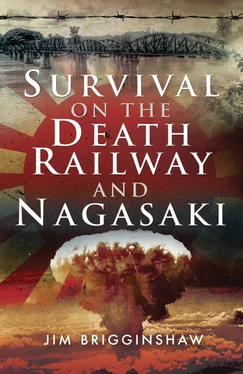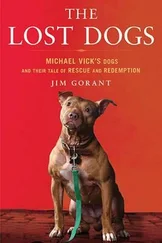The prisoners took the edge off their loathing by resorting to humour. If a noise at the padre’s end of the hut woke them during the night, somebody would comment that it was only the Pocket Battleship opening another tin of bully beef.
The Pocket Battleship’s proudest possession, apart from his food supplies, was a pair of tan army officer’s boots of the finest soft leather. He placed these carefully next to him each night while he slept.
One morning he slipped his feet into his boots and then quickly withdrew them again.
‘Somebody shat in my boots!’ the Pocket Battleship roared, adding an outburst of profanity not usually associated with a man of the cloth.
Disgusting as the act was, nobody offered him any sympathy.
Australian, British and American prisoners had another dislike-the Dutch. On the Burma Railway, they’d found them to be generally lacking in hygiene. Worse, the Dutch paid the Korean guards for rations that were intended for the other prisoners.
In River Valley, the word went out that the Dutch were buying the meat of native dogs, smuggling it into the camp and cooking it.
Medical officers had banned the eating of native dogs, fearing the animals could be diseased, and the last thing the camp needed was more disease.
When a party of Dutch men was seen carrying a covered five-gallon drum using a stick passed through the handle, six Aussies fronted them.
‘What’s in the drum?’ they asked.
The Dutch said it was meat they had bought from the natives, and went to move off, but the Australians barred the way.
‘Give us a look.’ Bodero whipped the lid off the drum. It was full of water. He plunged his hand in and brought out the hind leg of a dog.
‘A mangy bloody native dog!’ Tellemalie snorted.
The Dutch left in a hurry. The Australians followed them into their section of the camp, where they were confronted by at least a hundred men.
Nobody knew who threw the first punch, but within seconds a free-for-all had erupted and the vastly outnumbered Australians were getting the father of a hiding.
A British work party saw the brawl and joined in on the Aussies’ side. Then word spread to the Australian lines and reinforcements arrived, making the sides more or less even for the first time.
The brawl ended with the Dutch beating a hasty retreat.
The next morning, Australian medical officers taking the daily sick parade were confronted by walking wounded with black eyes, swollen faces, skinned hands, cuts and bruises.
One of the Dutch, who had a large amount of skin missing from his face, came looking for Jim Bodero. ‘Did you enjoy yourself yesterday?’the man asked.
Jim recognised him as one of his personal adversaries in the brawl and was ready for the bell to ring for a second round.
‘Yeah, not a bad blue’, Jim said. ‘What about it?’
The man held out his hand. ‘It was a good fight.’
Jim shook the man’s hand, and that was the end of the confrontation. It was also the end of the dog meat trade. As far as anyone knew, no more of it entered the camp.
More appropriate food became available after the Japanese arranged a fishing trip and took a few of the Australian prisoners with them. When their motorboat dropped anchor in a small bay in the harbour, the Japanese had the prisoners throw buckets of offal into the water. It wasn’t long before sharks were circling. The Japanese tossed hand grenades among them and several floated to the surface belly up. The sharks weren’t dead, only stunned, and it was a hazardous job getting them on board before they regained consciousness. The job was given to the prisoners.
The Japanese were so impressed when the task was completed without incident that they promised the prisoners one of the catch. Surprisingly, they kept their word and handed over a big shark. It was taken to the kitchen detail, who set about cleaning it before the Nips changed their mind.
It was like winning the lottery when they found another large fish in the shark’s gut. Fresh and intact, it must have been swallowed just before the grenades ended the shark’s swimming days.
The hungry men dined well that night.
CHAPTER TEN
DODGING TORPEDOES
IN October 1944, the six hundred Australian and three hundred British prisoners who had left Siam headed for Japan were paraded and told their transport convoy was ready to leave. There had been a change of plans, though. Three hundred Australians would be left at the Singapore camp and replaced by an extra three hundred British.
When it came to selecting the Australians who were to go, the Japanese took the first three hundred on parade. Among those staying behind were Tellemalie, Chilla Goodchap, Ronnie Crick, Fred Barnstable and Jim Bodero.
Barnstable, from Euchuca, Victoria, had become Bodero’s close friend when they were in the same woodcutting party at Tamarkan. They were to go through some shattering experiences together.
When the convoy of Japanese ships sailed, Jimmy Harris, Johnny Gorman and Sol Heffernan were among those on board, but they never reached Japan. The convoy was intercepted by American submarines between the Philippines and Japan, and most of the Japanese ships were sunk. The American subs picked up some of the men in the water, among them Jimmy Harris, but Johnny Gorman and Sol Heffernan were never seen again.
Jimmy Harris and the other survivors were taken by the submarines to Guam and Saigon and repatriated to Australia before the end of the war.
After the first convoy for Japan left Singapore, life continued in the River Valley camp as before. It was hard yakka for the work parties, but at least they avoided the dreaded dry dock.
On 16 December 1944, the second contingent of Australians, those who’d been left in Singapore, embarked for Japan. Five hundred were taken from the River Valley camp by trucks to the docks, where they were herded onto the Awa Maru, a smart-looking Japanese transport ship. Also on board bound for Japan were Japanese soldiers, civilians and female camp followers.
The five hundred Australian prisoners, urged on by bayonet prods and blows from rifle butts, were forced into a hold with space for perhaps one hundred. The hold was divided from top to bottom into tiers of decks about three feet apart, into which the men were crammed. Once in there, it was impossible to stretch out or stand up.
‘Like chooks in a bloody coop’, Tellemalie commented as he squatted next to Jim Bodero.
When the hold was filled to overflowing with men, it was locked and battened down. The prisoners only knew they were finally under way when they heard the throbbing of the engines and felt the vibration of the turning propellers.
Hours later, the hatch covers were removed and a hundred men at a time were allowed on deck to be fed a small ration of rice. They had half an hour in the fresh air before they were herded back into their prison.
These meal breaks, if they could be called meals, were to be the only respite from the torture of the packed, stifling hold. At such times, and only then, the prisoners were allowed to use the crude lavatories set up on deck, two wooden planks that protruded from the side of the ship out over the water. They could either stand or squat on the planks while holding on to the railing, with no protection from the weather and no privacy.
The primitive lavatories would have tested even fit men, so in the prisoners’ debilitated condition, and with waves slapping against their bare bottoms, drowning was a distinct possibility every time they were used.
Down in the hold, there were no lavatories, and the stench was overpowering.
The only time the men washed was when they were hosed down with salt water while on deck. Those who had tobacco were allowed to smoke in the brief time they spent out of the hold, but they had to carry some form of ashtray. The Japanese were dead scared they’d sabotage the ship by setting it on fire.
Читать дальше












